A SONG TO SING ALL OVER THIS LAND page 2 But first, Grossman had to watch his new trio. "We put together some material and auditioned for Albert, and Albert liked it," said Travers. Then the rehearsing started. "We worked solidly for seven months until we started to perform," said Yarrow. Early on, it was decided to bring in an arranger/musical director. "When we first started working together, we realized that we needed a musical director," Travers said. "We were just too different, all of us, and none of us wrote music, although Peter read, and the way we were arranging songs were head arrangements. You know, you just sit there and, 'What does this sound like against that?' But we needed somebody who could write the part down when we finally decided what the part was or give an occasional good suggestion when we'd run out of trying to figure out how to solve something." "I had hoped to get Bob DeCormier because he'd been my high school music teacher and he was the musical director for Harry Belafonte. But Bob was busy, had more on his plate than he could deal with, and he suggested Milt Okun. Milt came and heard us and thought we were cute, but wasn't thoroughly convinced that we had whatever it was. He suggested Freddie Hellerman of the Weavers, and Freddie came and heard us sing and called up Milt and said-- it is purported-- 'What are you trying to do? These kids can't do it.' So Milt came back as a favor to Bob one more time, and he said to himself, 'Okay, I'll get them in shape to do a concert, and I'm gonna walk away from this.' But you know how things are, you work with people, you get to like them and the next thing we knew .... So, he stuck with it, we stuck with it, and we worked with Milt for the first decade from 1961, really, to 1970. Milt was a wonderful co-worker. He never really arranged for us, but he was-- I don't know what you'd call-- he was the coach! More like a coach." (In the second phase of their career together, from 1983 on, their musical director has been Bob DeCormier.)
The group needed a name. Grossman originally suggested "the Willows," but then they hit upon the idea of adapting the line from from "I Was Born 10,000 Years Ago" about "Peter, Paul and Moses" to make "Peter, Paul and Mary." It was Paul's idea to change his name from Noel to Paul," Travers told Robbie Wolliver, "Peter, Paul and Mary sounded much more euphonic that Peter, Noel and Mary. It wasn't because it had biblical overtones that we liked it. Paul's name was Noel Paul Stookey, and while he was a student he had a little trouble with the word Noel. So he was kind of glad to shed it. Later he went back to it, but that's when he grew up." Stookey denied that becoming "Paul" was his idea. "It was Albert Grossman who was the one that convinced me that I should take Paul on as a middle name," he said. But he added that the name had been valuable. "Think about this," he said. "Symbolically, if the group had been the Willows, I'm not sure that we would have felt a value to our individual identities in the same way that being called Peter, Paul and Mary has encouraged us." In the fall of 1961, Peter, Paul and Mary finally were ready to play outside their apartments. Mike Porco, owner of Folk City, told Robbie Wolliver that Yarrow was playing a two-week engagement at the club as a a solo when Grossman approached him to book the trio. Porco said he wouldn't pay any more than he was paying for Yarrow, and Grossman agreed to add $20 to the fee himself. "It wasn't billed as Peter, Paul and Mary, because they were just trying out," Porco told Wolliver. "They didn't know if they would stay together. It was a rehearsal for them." "First, I would sing alone, then Noel would do comedy, and then the group would appear together," said Yarrow, "because we only knew 12 songs! It's true. And those songs were the songs of the first album." At the end of two weeks, Grossman offered Porco another two, even though he had lined up the rival club the Bitter End to showcase the group. Porco, who had now headlined Peter Yarrow four weeks running said thanks, but no thanks. Grossman still owes me the 20 dollars," he told Wolliver.
"Albert Grossman had a vision of a more accessible form of folk entertainment," said Stookey. "He understood and valued the tradition of folk music, but he saw no reason at all why it couldn't be available to more people. He was wise beyond his years. Albert would not have settled for Vanguard." "We went to RCA Victor first," said Travers, "and they said they didn't feel we were polished enough to record yet. Then we went to Columbia, and Columbia was interested, but they had an A&R man they wanted to give us who came to the club we were working in with a song that he said was a guaranteed hit. Now, I don't read music. So, I looked at the song, and it was a lot of , you know, moon, June, walk by the beach, the waves, blah, blah, blah, and I said, ' Well, what's the melody"' He said, 'Oh, it's a great melody, it's to a traditional song. "Red Rosey Bush."' I looked at him, and I said, 'Gee. Number one, "Red Rosey Bush" is a wonderful song and does not need these inane sappy lyrics. Number two, if you get somebody to record this song this way, you are looking down the barrel of a big lawsuit because "Red Rosey Bush" is not a traditional song. It was written by John Jacob Niles.' and I immediately said-- he was a very good-looking fellow-- 'this nice, good-looking fellow is an idiot, and we do not need this kind of help. I don't want somebody telling us what to sing, especially when they're wrong." Now, RCA had turned the group down, and the group had turned Columbia down. Among the remaining majors, Decca had not shown much interest in the folk boom since dropping the Weavers in the early '50s (with the exception of Burl Ives, who was considered a traitor by many folk enthusiasts for cooperating with the House Committee on UnAmerican Activities), and Capitol, with the Kingstons, didn't need another folk trio. But there was a fledgling label out on the West Coast called Warner Bros. Records, a subsidiary of the movie studio, that had been struggling, but was now under new management and had paid a chunk of money for the Everly Brothers the year before. "Warner Bros. Records was founded at 10:00 A.M. on March 19, 1958," wrote Timothy White. (The Nearest Faraway Place: Brian Wilson, The Beach Boys, And The Southern California Experience, New York: Henry Holt and Company, 1994) It's first couple of years were not successful ones. "Headed by Jim Conklin who had been president of Capitol and Columbia, the company tried to become a full-line record firm overnight, with a big catalogue representing too many kinds of music." wrote Steve Chapple and Reebee Garofalo. (Rock 'N' Roll Is Here To Pay: The History And Politics Of The Music Industry, Chicago: Nelson-Hall, 1977) By 1961, when Mike Maitland became it's president, the label, despite the success of Bob Newhart 's comedy albums and the still-hot Everlys, was losing $3 million a year. "The film company thought of closing down the record division," wrote Chapple and Garofalo, "but decided that it would lose even more money in unpaid bills owed by distributors." The record company's headquarters were adjacent to the studio in, as White put it, "the vacant top floor (above the machine shop) of a two-story auxiliary building at 3701 Warner Boulevard" in Burbank. But "auxiliary building' doesn't quite capture it. "They were housed in an old World War II wooden-frame building across the lot from the Warner Bros. picture company," said Travers. "You had to walk up the stairs." Even closer to the mark: "When we first visited Warner Bros.," said Stookey, "they were still in the Quonset huts that were out on the Warner Bros. movie lots. I mean, they were really the orphaned kids of Warner Bros." Grossman had a strategy about how to make a start-up label 3,000 miles away work to his advantage, but first he had to get the group signed, which is where Artie Mogull, a publisher at M. Whitmark & Sons (part of Music Publishers Holding Corporation, later renamed Warner Bros. Music) who served as Warner's East Coast representative, came in. Stookey told the story: "Mike Maitland called and said, 'I've been told [by Grossman] that there's a folk act appearing at the Bitter End. We're thinking of signing them. Would you go down and check them out?' And Artie said, 'Oh, absolutely.' Well, he didn't go. Mike called the next day and said, 'Artie, so what did you think?' 'Oh, Mike, geez, I'm terribly sorry, I got hung up late in meetings,' and he did a quick tap dance, and he managed to extricate [himself], said, 'But I'll get down there tonight and see them.' Well, something came up, and he couldn't come down again. The phone call came through the next day, and Maitland said, 'So, Artie, what did you think of them?' and without missing a beat, he said, 'They're great!' So, at least we got to first base. MAny times, that's what it takes." "Albert made a deal with them which was quite unique in the annals of record company contracts," said Travers. "Basically, contracts then were three albums, minimum of three albums they guaranteed, and a fairly healthy advance. They didn't have any money. Neither did we, but..."
Peter, Paul and Mary signed to Warner Bros. Records on January 29, 1962. According to Robert Shelton, they received a $30,000 advance. "Peter, Paul & Mary Ink WB Term Contract," read the headline in the February 3 issue of Billboard, the accompanying article noting that the trio, currently appearing at the Blue Angel in New York, would release an LP to coincide with their opening at the hungry i in San Francisco next month. The next step was an album. The trio discussed arrangements and repertoire among themselves in a rigorous manner that would continue throughout their career. "It's too bad you can't be a fly on the wall when we do an arrangement," Travers said. "Sometimes there's a song in which someone sounds really great 80 percent of the time singing melody and the other percent is out of their range. So, someone else sings that part, sings the melody. We switch leads. But the intellectual discussions and arguments that ensue when dealing with a song are really what's so much fun because we take it apart line by line. 'You believe that? I don't believe that. I love the song, but I don't believe in that line. Can we change that? Let's call the writer and ask him if we can change it.' And sometimes, fools that they are, they say no, and then we don't do the song." "Every song had to conform to the same criteria that it does today: It had to move us; it had to be something that would excite us in some way or delight us; and it had to resonate when we tried to sing it," Yarrow said. "There were a couple of songs we've tried working on that just didn't evolve properly. But mostly songs were floating around the Village anyhow or Mary or I had known them for years. 'This Train,' I wrote every note of that first arrangement. I just wrote it and came in and sang it. The second song was 'The Cruel War.' Mary sang the melody, I just sang the harmony on top. Mary and Noel just made up a lower harmony, and that was it." " Now, we started to get much more involved in terms of doing melodic lines that are contrapuntal to the lead line later. We started to think in terms of vocal lines that would suspend the chord that was being sung and establishing musical tension that way, although we dealt with it intuitively more than we did analytically." "We wanted to sing songs of substance," said Stookey, 'and even if they were frothy or light, they should have a piquancy. We always felt like something had to be worth doing. So, obviously, a gospel tune would be worth doing, a song with a traditional background would be worth doing. But when we got into the children's songs, we wanted them not just to be [sings] 'A,B,C,D,E,F,G,' but to have a character or some edifying or redeeming factor. We weren't always successful, but many times we were, and over the period of 35 years it has become almost a filter by which all songs must pass. Now, it's our own personal problem [laughs], but it works very well for us because it gives us a sense of continuity in our music. We assume other people notice this or at least other people are aware that something is always a bit-- it's not black and white with Peter, Paul and Mary, it's always got a shade of something to it. And that also translates into the chords that we choose to use from song to song. Taking 'It's Raining, It's Pouring' ["It's Raining," credited to Stookey], for instance, which probably still is a very familiar phrase or refrain among kids, and then adding the three nursery rhymes to it in music became also a point of departure." "I guess what I'm truly trying to say," Stookey continued, "is that much of what appeared to be scripted or constructed really was happenstance by some very talented people and became, not a blueprint, but a very comfortable means of looking at the process of creating this music for recordings. So, if you track all the albums, you'll see probably a gospel tune on almost every one."
"But these are not constructive, these are just who we are and the creatures into which we have evolved." You mean, asked the author, it's "organic"? "It's definitely a compost!" Stookey replied. "The bottom line," said Travers," is that I can go over almost every song, with the exception of maybe one or two-- and I'd have to go through them, through the whole catalog, to figure out which ones they were-- I would say 80 percent of it stands up today. 'You take a stick of bamboo' ["Bamboo," by Dave Van Ronk] doesn't. That's the first one." It worked in it's time, said the author. "Yeah, I'm saying, it doesn't now. It doesn't hold up long-term. But all of these songs, at the time, their lyric structure was something we believed in, or we felt totally comfortable singing. I remember something with some surprise in the second decade. 'Lemon Tree': Noel didn't want to song it anymore. 'Why?' we asked. He said, 'Because I don't believe in that line anymore.' As a new-born Christian, he would not say, 'Don't put your faith in love.' And we said, 'Oh, okay.' Because we would never, never ask somebody to sing something they didn't believe. And we have a one-veto vote. It's worked very well. Because we wouldn't want to do that. Can you imagine getting on-stage and singing something that you loathe?" Another major factor in polishing the material, again one that would continue throughout the group's career, was that it was road-tested. Even after they had achieved success, Peter, Paul and Mary constantly introduced new material on-stage prior to recording. "We didn't go around recording stuff we hadn't performed , with the exception of a couple of tunes," Travers said. If you've had a song in performance for 20 concerts, you know. You know whether it works. By the third concert, you've fixed whatever didn't work, and then by the tenth concert, it settles down and starts to have a life of it's own. There are dynamic changes and interpretive things that happen where you realize what you thought the song was about is still what the song is about, but that's another aspect to it that you didn't see when you first started singing it. I think that makes for a consistency, it means you can go in the studio and do it over and over again relatively, and then all you're doing is picking the best performance." Also unlike many other performers, Peter, Paul and Mary, at least at first, did not go into the studio and make elaborate arrangements with lots of added instrumentation, overdubbing and editing. "We were never monstrously big in taking a line from one track and a line from another," said Travers. "We did, but most the records we did were all live. We didn't lay down ornate tracks and then sing to them. By and large, we always tried to do live recording, where the three of us were in the same room singing at each other, and that tended to make for a realer sound. And then, I think, also, both Peter and Paul were very interested in the recording process, which helps when when you're mastering and mixing, and they both would spend a zillion hours in there. They're really good engineers, wonderful engineers." Yarrow noted that the group was restricted by a relatively primitive three-track recording process, a far cry from what is possible today. "But there is a gift to the old way of recording," he said. "One thing that was very important was that those were performances with the same kind of excitement in the studio that you had in an actual performance before a live audience, except of a different sort because you didn't have to get it [i.e., capture a single, one-time-only performance]. " "In the early days with the three track recording what you would do is actually intercut the takes, rather than what is done today, where you layer the recording so that you put on this voice and then that voice, and then you overdub the strings and whatever. You couldn't do that then. You could edit between takes [with] a razor blade, and [recording engineer] Bill Schwartau was a genius at that. Schwartau was a brilliant engineer and one of the people that taught Phil Ramone. We used to make diagrams where we would go back and forth between takes, and it was very interesting because it really did give you the best of-- generally it was between two takes, where you were building up and it really hit its stride [by] the middle of the take, and then you would get the first half of the the next take working like crazy, and then you'd lose that kind of crystalline sense of peak experience. So, you'd kind of get the end of one and the beginning of the other, and then maybe, one verse you'd go back and forth to the other, or a couple of lines, and if it worked, it worked, if it didn't, you would deal with it a different way."
As Travers noted, Grossman also had arranged that the group would control the album packaging. The cover photo, depicting the group posing onstage at the Bitter End before it's brick wall, was taken by Bernard Cole. The words "Peter, Paul and Mary" appeared in a striking, multi-colored script on the upper left. "We hired a very young art director named Milt Glaser," said Travers, "who was a student of the famous Henry Wolf, who was the graphic designer of that period. He was the guy who designed Show magazine, and Milt was his disciple. Of course, Milt is now hanging in the Museum of Modern Art. Milt invented that original typeface that we used, and he did all the graphics for the group, not just the album covers, but everything from Christmas cards to stationary, and became a wonderful friend and has remained a wonderful friend all of these years, and in fact this last album cover [LifeLines] was his'" "Albert selected Milt Glaser as the art director," said Stookey, "which was a real coup because in one deft swoop of his hand, Milt created a font for Peter, Paul and Mary that became identified with the group for the next 20 years, and probably still is. At the same time, Milt handled all of the album chores for the first decade. His design work was just amazing." Finally, there were the uncredited liner notes on the back cover, beginning with the direct statement: "Peter, Paul and Mary sing folk music." In a series of bold declarative sentences, the annotator emphasized the group's unadorned quality. 'The Truth is on the record,' he wrote, with the word "Truth" capitalized and in bold-face print. The author was "Albert's hidden partner, John Court, who was a man of letters," said Stookey. "John saw something in the group that we lived out, I mean that was almost prophetic. He saw that in the synergy created between these three people who were pulling individually, at the same time, it was a very strange kind of-- and still is, really, for it to be working as well as it is-- combination of individual requirements, needs, desires, and ultimately individual compassion that made this group work and function and bubble and flow in quick little rivulets to one direction or another, but always ending up in a very moderate steady pulsed direction. And John gave it a name. He called it truth, and he called it, away with ambiguity."
Both records hit the charts for the week ending April 28. "Lemon Tree" reached it's peak at #35 in the Billboard Hot 100 for the week ending June 9. The album became a massive seller, finally hitting #1 for the first of seven weeks for the week ending October 20. It would be certified gold on December 10 and ultimately sell over two million copies, staying in the charts 185 weeks, the 26th longest run of any album on the Billboard charts. But it wasn't just that the album stayed on the charts for more than three and a half years, it stayed high on the charts. On October 26, 1963, 19 months after its release, during its 79th week on the charts, it even returned to #1. Spending 85 weeks in the top 10, 112 in the top 40, it earned a ranking of #36 on a list of the top #1 albums of the '60s constructed by chart researcher Joel Whitburn. (Joel Whitburn's Top Pop Albums 1955-1992, Menomonee Falls, Wisconsin: Record Research, Inc., 1993) This initial record success, said Stookey, "was by no small part due to a man by the name of Don Graham. He was the Warner Bros. record promoter on the west coast then. I don't think he understood folk music traditionally, but he sure did know the contemporary music scene and the angst of the disc jockeys, that they were basically nice guys looking to have fun and play some really fun music. He tool us around to [radio stations] and there was a fellow by the name of Buck Herring who was a disc jockey at, I think it was, KSFO in San Francisco, who just started playing 'Lemon Tree.' He just fell in love with 'Lemon Tree.' which was a Will Holt tune and not really-- how shall I say?-- mainstream to what Peter, Paul and Mary were if you add up all the sounds, you know, if you try to find the median ground. 'Lemon Tree' was really kind of nightclubby compared to what we are, but nonetheless, Don took us there and squired us around San Francisco during that time." "At that time, we were fifth on the bill at the hungry i, and folk music was just tickling at the edges of people's consciousness. The Smothers Brothers were across the street at the Purple Onion. The Kingstons, of course, had established the hungry i as their home. So, to have another folk group come in, and particularly, to have a slim, energy-filled, dynamic woman like Mary Travers-- I mean, I've seen films and videos of us in retrospect, and I am blown away by Mary's ambiance, you know? And she, in retrospect, all the conversations I've ever heard her, all the interviews I've ever heard with her, she says it was nervous energy. I mean she was just petrified on-stage. But it really doesn't come off like that. It comes off like caged intensity." Part of Travers's mystique was that, on Grossman's orders, she never spoke on-stage. "She says that Albert spoke to her and said, 'I think that you will come off a lot better if you just let the guys do the talking, that you'll retain an aura of mystery,' ' said Stookey. "She makes some joke about it, because now she talks all the time on-stage, as all of us do. We talk much more than we should." In July, Warner Bros. followed the success of "Lemon Tree" by releasing "If I Had A Hammer" as a single. This was a very different kind of song from it's predecessor, and since it became so popular, it's worth exploring the song's origins. Originally titled "The Hammer Song," it was written in 1949 by Pete Seeger and Lee Hays, prior to the formation of the Weavers, at a meeting of the radical publishing organization People's Songs. The songwriters' intention with their stirring words and tune was to argue against the growing anti-Communist crusade of the late 1940's: The "warning" they wanted to "ring out" was a warning against right-wing extremism, and the "love between all of my brothers" (as the original lyric had it) carried explicit socialist implications. It was first sung at a benefit for 11 Communist Party leaders prosecuted under the Smith act. The Weavers recorded it on a single released by Harmony records in 1949. But the song was so provocative that, despite its obvious quality, the group never considered performing it or recording it after they signed to Decca and achieved national success in 1950. But it was published on the cover of the first issue of Sing Out! magazine (published by People's Artists, the successor to People's Songs) in May 1950. By 1962, though remnants of the red-hunting of the 1950's remained, few seem to have known or remembered the history of the song, which encountered no radio resistance. The single peaked at #10 on the Hot 100 on October 13, selling 700,000 copies.
"By 1973," Willens continued, "the song had so woven itself into the fabric of the nation that Senator Sam Ervin recorded it in his heavy southern drawl, with stirring passages of 'America The Beautiful' as background." (Lonesome Traveler: The Life of Lee Hays, New York: W.W. Norton 7 Company, 1988) "There is unquestionably a trade-off between reaching a broad audience through the mass media and the content or original meaning of a song," wrote Robbie Lieberman. "The question is whether the trade-off is worth it. Former People's Songsters disagree on the answer to this question-- there is no simple or objective answer-- but most acknowledge that the commercial world cannot be ignored. For example, there are 116 recorded versions of 'The Hammer Song.' Does this mean the song has been particularly effective in reaching people or that it has become meaningless because of its commercial success?" ("My Song Is My Weapon"; People's Songs, American Communism, And The Politics Of Culture, 1930-50, Urbana and Chicago: University of Illinois Press, 1989) Such questions cannot be answered easily. But the success of "If I Had A Hammer" in early 1962 seems to have been both an indication of and an encouragement to the decline of the red-baiting era, as well as an explicit bridge between the popularity and political commitment of the Weavers and that of Peter, Paul and Mary. Pete Seeger, whose indictment for contempt by the notorious House Committee on UnAmerican Activities finally had been dismissed by the U.S. Court of appeals in May, found that his version of the song harmonized with the Peter, Paul and Mary arrangement: At his concerts he would sing the original, and the audience could sing along with the new one. Travers had a similar experience later on. "I remember being in a political prison in El Salvador in '83 and singing with a young teacher who was a prisoner," she said. "He accompanied me, and we sang, 'If I Had A Hammer' together. Of course, we sang the Trini Lopez version! [Lopez had a #3 hit with the song in 1963.] But that was okay. A good song can be sung a lot of different ways." "If I Had A Hammer" won Peter, Paul and Mary 1962 Grammy awards for Best Performance by a Vocal Group and Best Folk Recording. They lost the Best New artist Award to Robert Goulet. In November, Warner Bros. released Peter, Paul and Mary's third single, "Big Boat," drawn from their upcoming second record album. The song, credited to Stookey/Lane/Okun/Mezzetti, had a lively arrangement reminiscent of the group's treatment of "If I Had My Way." But it failed to match the success of their first two singles, getting to only #93 in the Hot 100. Nevertheless, Peter, Paul and Mary's three chart singles during the year gave them a ranking of sixth among the top debut artists on the Hot 100, according to Joel Whitburn, (Joel Whitburn's Pop Singles Annual 1955-1990, Menomonee Falls, Wisconsin: Record Research, Inc., 1991)
Simultaneous with the album's release came a second single release, Mike Settle's "Settle Down (Goin' Down That Highway)," a lively performance that improved on the showing of "Big Boat," getting to #56. The LP broke onto the charts on January 19, when the debut album was still at #3. As of February 2, Peter, Paul and Mary had two albums in the top 10 at the same time, a situation that continued most weeks until the fall. (Moving) peaked at #2 on March 30, eventually staying on the charts 99 weeks. Warners finally found a hit single on the album on the third try. "Puff (The Magic Dragon)" (the parentheses were used only on the 45), released in February, entered the charts for the week ending March 16; it peaked at #2 on May 11, behind Little Peggy March's "I Will Follow Him." On Billboard's "Middle-Road Singles" (previously "Easy Listening ") chart (where "Lemon Tree" had hit #12 and "Settle Down" #14), "Puff" hit #1 for the first two weeks the same day. It even hit #10 on the "Hot R&B Singles" chart, Peter, Paul and Mary's only appearance on that list. Needless to say, "Puff" encountered no resistance at radio or from the commentators who later seized upon its supposedly subversive drug message. Stookey laments that this interpretation clings to the song, "no matter how many times we try to put the story to rest." [Peter's reply to the story] "I think we were three years beyond 'Puff (The Magic Dragon)'s' success," Stookey recalled, when a certain newsmagazine decided to have some fun. "The Newsweek article was in fact the first mention of anything like that, and as I understand it when one of the reporters was approached about it, he said shamefacedly, 'We were all sitting around complaining about what bullshit it was, this McCarthy scare about hidden lyrics. So, we decided that we would come up with the most innocuous song that we could think of in this pool of writers and say that it was purported to be [about drugs]." He said, "We never thought for a minute that it would take hold.' And it's still tearing at us."
On Saturday, April 6, 1963 ABC-TV broadcast the first show of it's new series Hootenanny between 8:30 pm and nine o'clock. Hosted by Jack Linkletter and taped before a live audience at a different college campus each week, the series reflected the enormous rise in popularity of folk music as represented by the Kingston Trio, Peter, Paul and Mary, the Rooftop Singers and others. In late February, however, Broadside magazine broke the story that the show was perpetuating the blacklist, reporting that Joan Baez had been approached to appear and had asked if Pete Seeger would be on the show. When told he would not, she declined. By the time of the first show's airing, the story was a national scandal. Reviewing that show in The New York Times on Monday, April 8, critic Jack Gould wrote, "Television's belated recognition of interest in folk singing ... is accompanied by one disquieting note. Apparently Pete Seeger's private political opinions continue to keep him off all network shows of folk singers." "Since he is at liberty to appear on stages and can be heard at home on recordings, why should TV prolong it's blacklist? Mr. Seeger's credential for TV is his art, which is in order." Peter, Paul and Mary found out why Seeger was unwelcome when Hootenanny reportedly offered them $25,000 to appear. "They wanted us very badly," said Travers. "They said, 'Please do the program,' and we said, 'Oh, we'd love to do the program with Pete Seeger.' And they said, 'No, we don't think so.' And we said, 'Well, we'll do it for free with Pete Seeger.' And they said, 'No we don't think he has any college appeal.' [laughs] And so we said, 'Thank you, but no thank you.' We said, 'Obviously, you're still in the grip of the blacklist.' 'Oh no, no, no, it's just we don't think he has any college appeal,' And if it hadn't been so tragic, we would have really laughed." In September, ABC tacitly admitted its real reason for banning Seeger when it informed him that if he furnished a "sworn affidavit as to his past and present affiliations,' it would consider booking him on Hootenanny. In other words, "Are you now, or have you ever been ... ," precisely the question that had led to Seeger's contempt citation from the UnAmerican Activities Committee. Of course, he refused. Hootenanny stayed on the air until September 12, 1964, without ever presenting the major names in folk music. It would be several years until the Smothers Brothers finally managed to break the blacklist on Pete Seeger, not long before having their variety show canceled over censorship disputes. Peter, Paul and Mary would appear on one of their final shows. Meanwhile, much had happened in the career of Bob Dylan since Noel Stookey advised Albert Grossman to keep an eye on him in June 1961. Grossman had met Dylan at the Gaslight that July. On September 29, Robert Shelton gave Dylan a favorable write-up in The New York Times. On September 30, Dylan met Columbia records A&R executive John Hammond at a Carolyn Hester recording session. Hammond signed Dylan to Columbia on October 26. On March 19, 1962, Columbia released Dylan's debut album, Bob Dylan, to scant notice. On April 16, the day of it's completion, Dylan's song "Blowin' In The Wind" was performed by Gil Turner at Folk City. It was published on the front page of the late May issue of Broadside. By June, Albert Grossman had taken over as Dylan's manager, buying out Roy Silver, a friend who had been booking the singer. According to Shelton, half of the $10,000 Grossman paid Silver for Dylan was provided by Peter, Paul and Mary, giving them a financial stake in his success. "From 1962 on," Shelton wrote, "there were rumors that Peter, Paul and Mary had a part interest in Dylan's future, but the trio's constant denials tended to make the arrangement seem sinister. All it meant was that the trio was backing privately what they said publicly: They believed Dylan had strong potential." "Blowin' In The Wind" confirmed that potential. Like "If I Had A Hammer" and "This Land Is Your Land," it is a song that has passed into the mass consciousness minus the context and specific meaning with which it was written. But no one who heard it in the early 1960's could have missed it's subject: "Blowin' In The Wind" is an anthem about civil rights (and to a lesser extent, disarmament). In its three verses containing nine rhetorical queries. The song asked the questions African-Americans and their Caucasian sympathizers had been asking for a decade. Lines like "How many roads must a man walk down before he's called a man?" (in the Broadside version; Dylan's recorded version went " ... before you call him a man?" while Peter, Paul and Mary would sing "before they call him a man") and "How many years can some people exist before they're allowed to be free?" addressed the civil rights movement's quest for dignity and equal treatment in the South, and Dylan also cited the white majority that feigned ignorance of the oppression the black minority suffered: "How many times can a man turn his head and pretend that he just doesn't see? ... How many ears must one man have before he can hear people cry?" The song's chorus, "The answer, my friend, is blowin' in the wind, the answer is blowin; in the wind," poetically spoke to the uncertain chances of the movement's success and the duration of the struggle at a time when a timid and distracted, if sympathetic Kennedy administration in Washington was dragging it's feet and Dr. Martin Luther King, Jr., and his followers and associates seemed to be fighting a city-by-city, day-by-day war for equality. "Blowin' In The Wind" crystallized the feelings of blacks and whites in the early 1960's, and long after it's specific inspirations have faded it remains stirring as a broader philosophical statement.
Okun decided it was a good song for the Mitchells, who began to perform it and were sufficiently enthusiastic to record it for their next album. "Blowin' In The Wind" made it's first appearance on record on The Chad Mitchell Trio In Action (Kapp Records 3313), released in March 1963, but, apparently due to a dispute with their producer Bob Bollard, who preferred they steer clear of political material, the Mitchells did not release the song as a single. (Later, Kapp would rename the album Blowin' In The Wind.) Toward the end of 1962, Grossman approached Peter, Paul and Mary with the song. "With very few exceptions, the songs came from the three of us," Yarrow said. "Albert suggested a few songs. He brought us 'Blowin' In The Wind,' even though we knew Bobby. He came to us with an acetate when we were at the Gate of Horn performing, and I remember that I just freaked out over it. He was more possessed about 'Don't Think Twice,' and I thought 'Blowin' In The Wind' was just about the best song I could have imagined at the time. It was the first time that we went in and recorded a song and put it out as a single long before it was on an album. The rest of the time we'd put out an album, and we'd see what the pundits from the field would say then release a single." (Passed on by Peter, Paul and Mary for the moment, "Don't Think Twice, It's All Right" was released on Atlantic Records in late May as the debut single by a new folk trio, the New World Singers, whose members were Gil Turner, Happy Traum and Bob Cohen. But it did not chart, and Peter, Paul and Mary would get around to it a little later.) Warners did not release the song immediately, instead letting all the singles from (Moving) run their course in the early months of 1963, but Peter, Paul and Mary began singing "Blowin' In The Wind" at their concerts. "They always introduced it with the line: 'Now we'd like to sing a song written by the most important folk artist in America today, Bob Dylan," wrote Anthony Scaduto. (Bob Dylan: An Intimate Biography, New York: Grosset & Dunlap, 1971) "I don't recall actually touting his career," said Stookey. "I think we just did a lot of his material, which of course accomplished the same thing. But I don't even recall mentioning his name on-stage. It was just common knowledge that there were some lyrics here that were going to hit you between the eyes." Warner Bros. finally released Peter, Paul and Mary's recording of "Blowin' In The Wind" on June 18, 1963, during the week that "Puff" fell off the charts. Proof that the song's point was possible to miss came with the review in the June 22 issue of Billboard, which described "this slick ditty" as "a sailor's lament, sung softly and tenderly." In it's first eight business days of release, "Blowin' In The Wind" sold 320,000 copies, making it the fastest selling single in Warner's five-year history. It entered the charts for the week ending June 29, peaking at #2 behind Little Stevie Wonder's "Fingertips (Part II)" on the chart for the week ending August 17. (It spent five weeks at the top of the Middle-Road Singles chart, starting on August 3.) It remains the most successful single recording of a Bob Dylan song on the Hot 100. Though never certified by the Record Industry Association of America, it is reported to have sold two million copies. It would win Peter, Paul and Mary Grammy Awards for Best Performance by a Vocal Group and Best Folk recording for the second year in a row. ("Puff, The Magic Dragon," nominated for Best Recording for Children, lost to Leonard Bernstein's Bernstein Conducts for Young People.)
Newport had not had folk festivals in 1961 or '62, but the festival was re-started in 1963 by George Wein, who formed a committee consisting of Theo Bikel, Jean Ritchie, Pete Seeger, Clarence Cooper, Erik Darling, Bill Clifton and Peter Yarrow to organize the event. As one of the younger voices on this board of directors, Yarrow focused attention on newer performers, who he said should get their own showcase. Yarrow spoke of his "belief that young singer-songwriters were really important, and at my insistence at the Newport board that we acknowledge these new singer-songwriters in a concert that I offered to put together and host, and I would choose it and book the talents on Sunday mornings. It was called the New Folks Concert. To me, we were missing the boat if all we were doing was just celebrating the traditions from which the music of Peter, Paul and Mary and Joan Baez and Bob Dylan came. Important as that was, the other important legacy that we had to acknowledge and protect was that of the urban, educated singer-songwriter and performer in the folk idiom who didn't necessarily emulate the traditional musical form but just its spirit and it's soul, hopefully in a tasteful way. And so, that New Folks Concert was totally consistent with that vision that Yarrow would continue throughout his career, as he helped found the Kerrville Folk Festival and other forums for developing singer-songwriters. At Freebody Park in Newport, Rhode Island, on July 26-28, 1963, before an audience estimated at between 37,000 and 46,000 people, such emerging performers as Tom Paxton, Phil Ochs, Peter La Farge and Ian and Sylvia got to display their talents, along with an older generation including Ramblin' Jack Elliot ad Ed McCurdy, folk blues performers like Mississippi John Hurt and gospel-oriented groups like the Freedom Singers (including Bernice Johnson, later Bernice Reagon, who would go on to found Sweet Honey in the Rock). But of course the major names at the festival remained Joan Baez, Bob Dylan and Peter, Paul and Mary. The last evening closed with Dylan singing "Blowin' In The Wind," joined by Baez, Peter, Paul and Mary and the Freedom Singers, followed by the inevitable "We Shall Overcome." (Excerpts from the festival, featuring an uncredited Peter, Paul and Mary, can be heard on the 1964 Vanguard Records album The Newport Folk Festival, 1963-- The Evening Concerts, Vol. 1.) The same people reconvened a month later for the March on Washington. (highlights of the March, including a snippet of Peter, Paul and Mary's performance, can be heard on the 1964 Folkways Records album We Shall Overcome!) Yarrow spoke of the relationship between the music and the political movements of the time. "In no way did I think that folk music alone was going to do it, but I did think it was more than simply the window dressing or the accompaniment to events that were changing the concept of Americans as to who they were and what they might be on a day-to-day basis," he said. "I felt that it had a reciprocal relationship with those events. Events would articulate themselves, and then the music would comment on them and form a consensus for certain people who were listening to the music, and that would be fed back into the system, and energizing it, and so forth and so on, rocking back and forth and moving forward, and it was in this way that the civil rights movement proceeded. It was in this way that the anti-Vietnam War movement proceeded." The week of the March on Washington, as the group spent its evenings appearing with Odetta at the Carter Barron Amphitheatre, Warner Bros. released Peter, Paul and Mary's sixth single, "Don't Think Twice, It's All Right." The result was a third straight Top 10 hit, as the single peaked at #9 for the week ending October 26. In September, Peter, Paul and Mary toured the U.K., also playing a date in Paris. (They were reported to be recording songs in German, French and Italian for the European market.) In England, "Blowin' In The Wind" entered the charts the following month, getting to #13 and paving the way for Dylan's appearance there the following spring. In America, Dylan's second album, The Freewheelin' Bob Dylan, containing his versions of "Blowin' In The Wind" and "Don't Think Twice, It's All Right," released the previous May, finally made the charts in the wake of Peter, Paul and Mary's hit versions. It would reach #22 and, after seven years, go gold. On September 23, Warner Bros. Records and Frank Sinatra's Reprise Records signed a merger agreement by which Reprise became a subsidiary of Warner, while Sinatra received one-third of the shares of the combined company and a seat on it's board of directors, also agreeing to a movie deal with the parent motion picture company. The deal brought in Reprise head Mo Ostin as the second-in-command at Warner. At the end of the month, company president Mike Maitland announced that the fiscal year 1962-1963, ending September 30, had been the most successful in the company's history, due largely to Peter, Paul and Mary. Warner Bros. Records was now a major record label.
The world was ready to receive that feelin': In The Wind blasted onto Billboard's Top LP's chart for the week ending October 26 at #12. That week, the typically busy group was touring the West Coast, playing primarily at colleges-- the University of Colorado on the 22nd; Central Washington College on the 23rd; the University of Puget Sound on the 24th; the Civic Auditorium in Stockton, California, on the 25th; South Nevada University on the 26th. That week Peter, Paul and Mary returned to #1; (Moving) moved up from #6 to #4. But the commercial peak in the career of Peter, Paul and Mary occurred the following week. In Billboard's November 2 issue, the group's three albums were all in the top 10: In The Wind hit #1 for the first of five weeks; Peter, Paul and Mary dropped to #2; (Moving) was #6. There would be 10 more weeks from now through February 1964 that the three albums would rank in the top 10 together. In The Wind was certified gold on November 13, only a month into release; it stayed in the charts 80 weeks. By the end of the month, Warner Bros. merchandising director Joel Friedman announced that Peter, Paul and Mary had sold a million copies in the U.S. alone, not counting record club sales. (At this time, a gold record award indicated sales of $1 million' worth of records at manufacturer's wholesale prices, certified by the Record Industry Association of America, meaning sales of roughly half a million copies. Platinum record awards for sales of a million copies were not instituted until 1976.) The third single from In The Wind, released in November, was "Stewball," the ballad of a hapless but triumphant racehorse that had been suggested to the group by Grossman. Though the album credits it to Mezzetti/Stookey/Okun/Travers, "Stewball" is based on a 19th century song called "skewbald," and it's worth noting that much of the group's repertoire was coming to be made up of traditional or non-copyright material for which they had provided new lyrics and arrangements. For example, In The Wind also included "Tell It On The Mountain," a version of the gospel song "Go Tell It On The Mountain," credited to "Stookey/Yarrow/Okun/Travers," and "Freight Train," a song identified with folk singer Elizabeth Cotton, here credited to "Mezzetti/Stookey/Okun/Travers." "Stewball" was not as big a hit as its predecessors, peaking at #35 in the Hot 100 on December 28. Even before then, Warner Bros. had released "A'Soalin'" from (Moving) as a Christmas single; it missed the Billboard chart, but spent two weeks in the Cash Box magazine Top 100, peaking at #79. The group's seven singles in release during 1963, three of which reached the Top 10, placed them at seventh place among the top singles artists of the year, according to Joel Whitburn. In its year-end issue, Billboard ranked Peter, Paul and Mary the top LP artists of 1963. Warner released a fourth single from In The Wind with "Tell It On The Mountain" in February 1964, as the hard-working trio played a string of one-nighters in the upper south, then went on to the upper midwest. It peaked at #33 in Billboard on April 4 (getting two notches higher in Cash Box). Billboard's March 28 issue contained a "Music On Campus" supplement including an article about Albert B. Grossman Management (ABGM): "It's 'Folkthink' At ABGM." "Most valuable property at ABGM is Peter, Paul and Mary, who play from four to six college concerts a week," the article reported, citing Charles Rothschild of the company. "When Peter, Paul and Mary play a college date, ABGM has program books on hand for $1 a throw. The act stays after the concert and autographs the books for the collegians. The books carry articles by and about the artists."
No wonder. The same week that 'Tell It On The Mountain" peaked on the Hot 100, the Top Five read as follows: #1 "Can't Buy Me Love," by the Beatles; #2 "Twist And Shout," by the Beatles; #3 She Loves You," by the Beatles; #4 I Want To Hold Your Hand," by the Beatles; and #5 "Please Please Me," by the Beatles. The Beatles also occupied #s 31, 41, 46, 58, 65, 68 and 79. Noel Stookey, for one was impressed. "The Beatles ... were very self-effacing and really clever and wonderful musicians," he said more than 30 years later. "We have not begun to scratch the impact that the Lennon-McCartney music machine will have on us in the next century. Did you see a very strange movie [set] at some time in the future called Demolition Man? Do you remember the musical hook? It was the fact that everything was done in snippets. They were all 30-second and 60-second commercials. That's what people really loved. They all wanted to hear the commercial tunes. [In the film, the commercial jingles of the present day have become the popular music of the future.] "Well, I think, to a large extent, the enormity of music that was produced by Lennon and McCartney just was staggering. We just haven't as a a people begun to process it. I think some of the lyrics may be of their time, but I think melodically the pieces are just classic. And as it comes back, they're just going to be gorgeous rewoven in countless different ways and reperformed in countless different ways." Immediately, of course, the dominance of the Beatles and the British pop-rock performers who followed in their wake acted as overwhelming competition to all existing performers and genres of popular music, including folk singers Peter, Paul and Mary. One area in which the Beatles did not compete with the trio-- not yet, anyway-- was in their political influence. In "Three's Company," an article published in the Saturday Evening Post on May 30, Peter Yarrow told authors Alfred G. Aronowitz and Marshall Blonsky that his group could "mobilize the youth of America .. in a way that nobody else could," even to the point of swaying a presidential election if they traveled with a candidate, something that, considering the upcoming race between Lyndon Johnson and Barry Goldwater, they did not intend to do. (Quoted in Minstrels Of The Dawn: The Folk-Protest Singer As A Cultural Hero, by Jerome L. Rodnitzky, Chicago: Nelson-Hall, 1976) Four years later. Yarrow would put this assertion to the test. In June, as the trio toured Australia, Warner Bros. joined the new rock 'n' roll fervor-- after a fashion-- by releasing as a new Peter, Paul and Mary single "Oh, Rock My Soul (Part 1)," an edited version of one of the selections on the group's upcoming double-LP set Peter, Paul and Mary In Concert. Credited to Yarrow, it was a new version of one of the old gospel song 'Bosom Of Abraham." It grazed the charts, peaking at #93. The summer of 1964 was "Freedom Summer," a season when civil rights workers streamed into Mississippi to register black voters. Among those workers were two white New Yorkers, Andrew Goodman and Henry Schwerner, and a black man from Meridan, Mississippi, James Chaney, all in their twenties, who disappeared on June 21. Their bodies were found on August 4 in an earthen dam. At Goodman's funeral, Peter, Paul and Mary sang, "How many deaths will it take..."
|
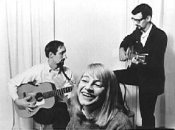 It is possible that
someday listeners will get to hear what those early rehearsals sounded like.
"I was really into tape-recording and radio when I was in high school, and
when I went to Greenwich Village I brought a lot of my original sound
equipment", said Stookey. "So, Peter and Mary and I
recorded as test recordings, oh, probably a half dozen tunes. We never
took them beyond singing in the living room, but I've got them on a 7 1/2 tape,
and I'm waiting for the Biograph [i.e. the boxed set]!"
It is possible that
someday listeners will get to hear what those early rehearsals sounded like.
"I was really into tape-recording and radio when I was in high school, and
when I went to Greenwich Village I brought a lot of my original sound
equipment", said Stookey. "So, Peter and Mary and I
recorded as test recordings, oh, probably a half dozen tunes. We never
took them beyond singing in the living room, but I've got them on a 7 1/2 tape,
and I'm waiting for the Biograph [i.e. the boxed set]!"
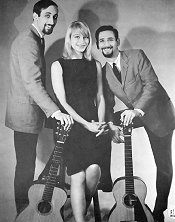 Peter, Paul and
Mary moved on to
Peter, Paul and
Mary moved on to 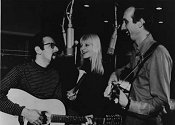 "So, Albert
said. 'Look. let's make an album. You pay for the album. We're not
going to record the album in California the way normal people do. We're
not going to let yo do the artwork, we're going to send it to you.
We'll make the whole thing, We'll master it, everything, and you'll just
pay the bills. You don't have to give us an advance. You don't have
to sign us up. You're not obligated to do three albums. If the album
doesn't happen, it's a wash. You have minimal exposure. But if the
album does well, then this is what we're going to want,' and it was more
than anybody in the business got. Warners said, 'Sure.' So, we had a
great deal of control. We had absolute control over what went on the
album, absolute control of how it was mastered."
"So, Albert
said. 'Look. let's make an album. You pay for the album. We're not
going to record the album in California the way normal people do. We're
not going to let yo do the artwork, we're going to send it to you.
We'll make the whole thing, We'll master it, everything, and you'll just
pay the bills. You don't have to give us an advance. You don't have
to sign us up. You're not obligated to do three albums. If the album
doesn't happen, it's a wash. You have minimal exposure. But if the
album does well, then this is what we're going to want,' and it was more
than anybody in the business got. Warners said, 'Sure.' So, we had a
great deal of control. We had absolute control over what went on the
album, absolute control of how it was mastered."
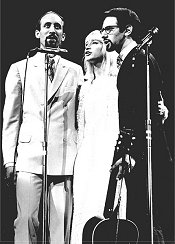 "You'll see a
children's song on almost every one. And you'll see Noel straining to
introduce major seventh chords and jazz chords and, you know, do zany stuff,
sound effects, crazy stuff, and really to a large extent I still contribute
that. I use the word 'contribute' in a very generous sense here. And
Peter, intense, political, causal, from the interpersonal, 'We are only one
river' to 'Light one candle' to Day is done.' And Mary, she always
kept the romance alive, whether it was 'Jet Plane' or 'The Water Is Wide' or
even the poignancy on the new album [Lifelines] of 'House Of The Rising Sun.'
She personalizes many times, and makes sure that that's part of the album.
"You'll see a
children's song on almost every one. And you'll see Noel straining to
introduce major seventh chords and jazz chords and, you know, do zany stuff,
sound effects, crazy stuff, and really to a large extent I still contribute
that. I use the word 'contribute' in a very generous sense here. And
Peter, intense, political, causal, from the interpersonal, 'We are only one
river' to 'Light one candle' to Day is done.' And Mary, she always
kept the romance alive, whether it was 'Jet Plane' or 'The Water Is Wide' or
even the poignancy on the new album [Lifelines] of 'House Of The Rising Sun.'
She personalizes many times, and makes sure that that's part of the album.
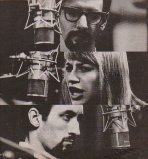 Yarrow also noted a
crucial mixing decision that affected the sound of Peter, Paul and Mary's
records.: "It was Albert that suggested that we not put the voices in
the center, which was the convention at the time, but put them hard right, hard
left and center ... and then we saw a different perspective on these tapes,
whereby Mary had her own channel and Noel had his own channel and I had my own
channel. Noel and I had our guitars with us on the channels, and the bass
was sometimes on one channel or another. But that meant that we actually
really separated the voices, and it gave you that spatial quality to the first
records where you could virtually walk inside the middle of it, turn off
my channel, listen to Noel's guitar and just learn the parts ... Noel and
I actually did the remix when we worked with Bill Schwartau. So, it was
our ears and our taste that was involved then."
Yarrow also noted a
crucial mixing decision that affected the sound of Peter, Paul and Mary's
records.: "It was Albert that suggested that we not put the voices in
the center, which was the convention at the time, but put them hard right, hard
left and center ... and then we saw a different perspective on these tapes,
whereby Mary had her own channel and Noel had his own channel and I had my own
channel. Noel and I had our guitars with us on the channels, and the bass
was sometimes on one channel or another. But that meant that we actually
really separated the voices, and it gave you that spatial quality to the first
records where you could virtually walk inside the middle of it, turn off
my channel, listen to Noel's guitar and just learn the parts ... Noel and
I actually did the remix when we worked with Bill Schwartau. So, it was
our ears and our taste that was involved then."
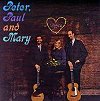 Peter, Paul and
Mary
Peter, Paul and
Mary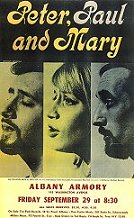 That was only the
beginning. "If I Had a Hammer" has gone on to become a
standard. "That the message of 'If I Had A Hammer' can be read in
many ways is evident from some of the requests for permission to use the
song," notes Doris Willens, "for a Save the Children Federation
public-service television spot; as the theme for a civic campaign to
modernize the government of Harrisburg, Pennsylvania; for a National Film
Board of Canada documentary; as a campaign song for Kenneth Monfort,
running for the Democratic nomination for U.S. Senate from the state of
Colorado.
That was only the
beginning. "If I Had a Hammer" has gone on to become a
standard. "That the message of 'If I Had A Hammer' can be read in
many ways is evident from some of the requests for permission to use the
song," notes Doris Willens, "for a Save the Children Federation
public-service television spot; as the theme for a civic campaign to
modernize the government of Harrisburg, Pennsylvania; for a National Film
Board of Canada documentary; as a campaign song for Kenneth Monfort,
running for the Democratic nomination for U.S. Senate from the state of
Colorado.
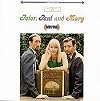 (Moving)
(Moving)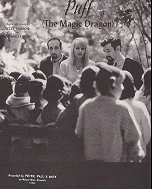
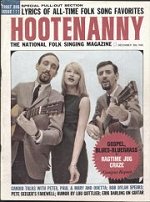 On July 9, 1962,
Dylan recorded "Blowin' In The Wind" for Columbia, though it
would not be released for almost 11 months. Grossman, who had
arranged a song publishing deal for Dylan with Artie Mogull, gave an
acetate of "Blowin' In The Wind," along with another Dylan
composition, "Tomorrow Is A Long Time," to Milt Okun, who, in addition
to his work with Peter, Paul and Mary, now worked with the Chad Mitchell Trio
and the Brothers Four.
On July 9, 1962,
Dylan recorded "Blowin' In The Wind" for Columbia, though it
would not be released for almost 11 months. Grossman, who had
arranged a song publishing deal for Dylan with Artie Mogull, gave an
acetate of "Blowin' In The Wind," along with another Dylan
composition, "Tomorrow Is A Long Time," to Milt Okun, who, in addition
to his work with Peter, Paul and Mary, now worked with the Chad Mitchell Trio
and the Brothers Four.
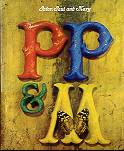
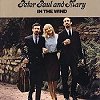
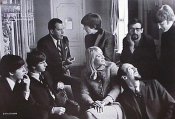 Peter, Paul and
Mary placed first in the supplement's ranking of most popular folk groups on
campus, but the most popular group in general was a recent name:
Peter, Paul and
Mary placed first in the supplement's ranking of most popular folk groups on
campus, but the most popular group in general was a recent name: